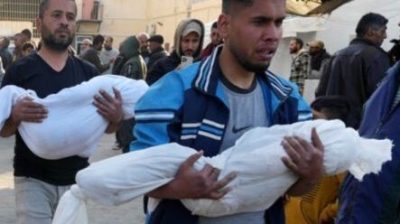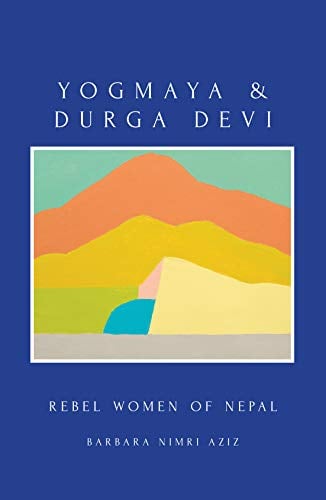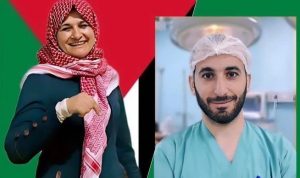Palestine: Anonymous Men Who Bury a Nation’s Martyrs

All Global Research articles can be read in 51 languages by activating the Translate Website button below the author’s name (only available in desktop version).
To receive Global Research’s Daily Newsletter (selected articles), click here.
Click the share button above to email/forward this article to your friends and colleagues. Follow us on Instagram and Twitter and subscribe to our Telegram Channel. Feel free to repost and share widely Global Research articles.
Global Research Referral Drive: Our Readers Are Our Lifeline
***
We wring our hands and shake our heads sadly as the toll mounts. Palestinian corpses along the roadside, limp bodies pulled from rubble, wrapped figures large and small laid outside a hospital or beside a tent. Viewing these images from afar is painful enough. But what about those young men who day-after-day carry away for burial that endless stream of bodies?
Heroes worthy of notice, respect, gratitude – you’ve seen them, lightly clad, sometimes bloodied, unkept, their eyes downcast as they wait for relatives to bid farewell to loved ones, or some stranger absorbed in securely binding a shroud. Thousands of overlooked able young men, themselves survivors, come forward for this weighty, urgent burden.
Today in Gaza, there is no safe place – not for those still standing, not for the wounded, not even for the dead. But the dead must be interred, must be honored with the simplest prayer. This is made more onerous by Israel’s bulldozing cemeteries, its tanks churning scattered bits of hardly retrievable souls across their boundaryless killing field. Even burying the dead in Gaza is dangerous; neither open fields nor roadways are safe from snippers and drones. Whatever the danger, these young pallbearers readily take up this solemn task. With every lost Palestinian deemed a martyr, their work is imbued with nobility if not holiness.
Since time immemorial, following whatever tragedy – personal or national, infant or elder, fighter or civilian – every people possess some means, from the most rudimentary to the ostentatious, to solemnize transition from the realm of the living, the sentient sphere, into the ‘beyond’.
A son stolidly lights the wooden pyre of his parent; crewmen tip a platform holding the body of a colleague who died while at sea; there are flag-draped caskets and gun salutes for veterans; a grieving relative will toss a handful of earth on a lowered coffin; a partner stores ashes of a loved one to be mingled later with their own; a grieving nation amasses flowers at the gate of a palace; a lone wooden stake marks the roadside site a fatal accident. A simple nod of the head may be all that’s needed; or, a band of musicians follows a garlanded body enroute to the burning ghat to celebrate their long life. A family entombs its exalted lineage in extravagant vaults; on a windswept mountain a lone figure piles stones over a shallow grave; elsewhere two workers unceremoniously feed human remains to carrion birds, as in Tibet.
In every culture, survivors are impelled, in one way or another, to mark the transition from life to death.
Without that, ghosts wander through a residence, a whole community becomes unsettled, an entire nation is agonized.
The universe itself may feel unstable or unruly to some. The quotidian ‘no closure’ hardly expresses the distress of those left unassuaged. If grieving is unsatisfied through prayer or propitiation, a blood revenge may erupt, survivors go mad, families split.
Whatever method of ‘burial’ a culture mandates, the disposal is solemn, ideally overseen by practitioners using traditional invocations: verbal or written, with floral, liquid or perfumed gifts.
But what happens when no one is available to cleanse and wrap a body?
Who will carry it to a safe place, to sanctify the transition?
Image: Dr. Yusra al-Maqadmeh and her son Dr. Ahmad Al-Maqadmeh, martyred at Al-Shifa Hospital, Gaza, April 2024.
One must ask what Gazans do when whole families have perished or are homeless and widely dispersed, where there’s no water for purification, where priests are unreachable. Who is there to utter the simplest prayer invoking the divine to receive this latest soul into heaven?
The rate of Palestinian deaths these months has few comparisons in recent history.
Often bodies of those lost cannot be retrieved. In the early weeks of the Israeli assault, we saw images of mass graves.
Rows of bodies enveloped in tarp waiting to be covered. With the mounting deaths, with cemeteries crushed by enemy bulldozers and tanks, with few if any vehicles to transport bodies, without functioning morgues, with no-known-family available, everything is makeshift.
Burial rituals have to be minimized; yet they must be completed. In the case of Palestinians killed in this war, the burden of their interment is sustained by the knowledge that each one is a martyr. Every baby, resistance fighter, mother lost during childbirth, youth crushed by a falling sack of flour, whether named or unidentified, all are shaheed, martyr: – one who suffered persecution for their religious or national beliefs.
Muslim women do not carry the corpse or attend the gravesite – this is the norm prescribed by most cultures. In Gaza therefore it is men, mostly young men, who convey the dead from hospitals or streets for burial. Some may manage to find a cart for the load; most have only their thinning arms. Gazing at images of them at their urgent work, it is difficult to know their thoughts. Their dress is casual, even inadequate. I suspect most grip the body of a stranger.
These noble bearers may manage their task alone, or with a single helper to dig the grave. The simplicity of Islam allows any humble layman to invoke the barest prayer for a martyr. If they did not know the words before, they know them now. What they devise to mark a grave, I do not know.
Recognizing the noble task of these Palestinians, I am reminded of the Tibetan method of what is called sky burial. In the past at least, after ritual cleansings, a body is conveyed, sometime by horse, sometimes on the back of a helper, to a sacred elevated rock – a place closely monitored by carrion birds. There, corpses are cut and broken into edible pieces manageable for the gathering vultures. This work is done by designated laymen. Neither priests nor members of a polluted class, they are nevertheless highly esteemed for this sacred work. (Called stobs-ldan in Tibetan – men-of-great-strength.) Theirs is a noble act, just as those young Palestinian men praying for a martyr he has carried to their resting place.
*
Note to readers: Please click the share button above. Follow us on Instagram and Twitter and subscribe to our Telegram Channel. Feel free to repost and share widely Global Research articles.
Barbara Nimri Aziz whose anthropological research has focused on the peoples of the Himalayas is the author of the newly published “Yogmaya and Durga Devi: Rebel Women of Nepal”, available on Amazon.
She is a regular contributor to Global Research.
All images in this article are from the author
 “Yogmaya and Durga Devi: Rebel Women of Nepal”
“Yogmaya and Durga Devi: Rebel Women of Nepal”
By Barbara Nimri Aziz
A century ago Yogmaya and Durga Devi, two women champions of justice, emerged from a remote corner of rural Nepal to offer solutions to their nation’s social and political ills. Then they were forgotten.
Years after their demise, in 1980 veteran anthropologist Barbara Nimri Aziz first uncovered their suppressed histories in her comprehensive and accessible biographies. Revelations from her decade of research led to the resurrection of these women and their entry into contemporary Nepali consciousness.
This book captures the daring political campaigns of these rebel women; at the same time it asks us to acknowledge their impact on contemporary feminist thinking. Like many revolutionaries who were vilified in their lifetimes, we learn about the true nature of these leaders’ intelligence, sacrifices, and vision during an era of social and economic oppression in this part of Asia.
After Nepal moved from absolute monarchy to a fledgling democracy and history re-evaluated these pioneers, Dr. Aziz explores their legacies in this book.
Psychologically provocative and astonishingly moving, “Yogmaya and Durga Devi” is a seminal contribution to women’s history.


